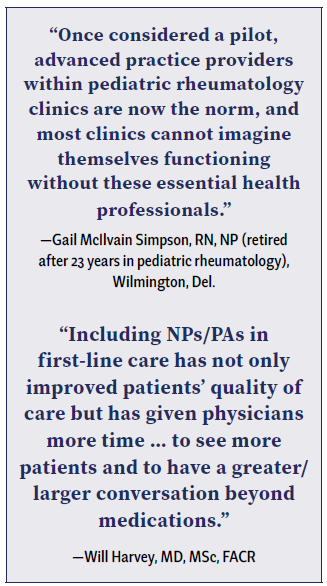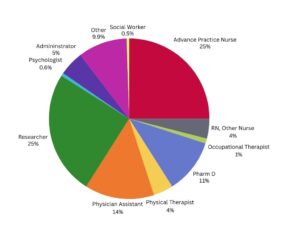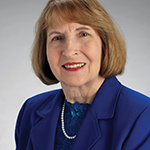Expanding the Rheumatology Workforce
A significant shift in rheumatology practice and in ARP membership was the introduction of APPs into the rheumatology workforce. Until the mid-1990s, few PAs or NPs worked in rheumatology. By 2005, however, 25% of rheumatologists reported working with APPs and another 25% anticipated hiring one within the next five years.4 This recruitment was originally driven by ongoing concerns that demand for rheumatology services would far exceed supply. The ACR’s 2005 Workforce Study report recommended incorporating APPs, and by 2015, the Workforce Study report included APPs in workforce estimates.4,5
Initially recommended as a pragmatic solution to workforce shortages, APPs proved exceptionally well suited to the field. Working alongside physicians in rheumatology practice, they have excelled in providing many functions, such as routine clinical care, triage, managing calls, follow-up and referrals.
Their contributions allow practices to see more patients and can often free up time for rheumatologists to focus more on complex medical decision making.
This expanding workforce brought an influx of NPs and PAs into the ARP, broadening both its membership and the range of professional roles it represents. A common thread between the original ARP members, who traditionally worked outside physician offices, and the new membership groups, who work inside physician offices, is a focus on helping patients articulate and achieve their goals.
The ARP’s role in this workforce expansion was to help orient APPs to the specialty. Rising to the occasion, the organization created educational products, such as the online Advanced Rheumatology Course, the NP/PA Core Curriculum and The Training Rheum. Numerous rheumatology practices have now incorporated APPs into their care teams, further strengthening the ARP through the addition of NP and PA members. The Rheumatology Research Foundation offers scholarships for training and mentorship, which enable NP and PA members to take advantage of educational opportunities to hone their skills.
Additionally, pharmacologists, infusion nurses, nurse case managers, research coordinators and other professionals have further expanded the rheumatology workforce and enriched the ARP membership’s rich diversity. The organization now includes 24 distinct disciplines within its membership (see Figure 2).
Although increasing the number and varied disciplines of ARP members is a valuable step toward addressing workforce demands, it will not be enough. The demand is predicted to increase as both the population and the rheumatology workforce age. This gap has been documented for physicians and APPs, and similar trends are anticipated among other essential rheumatology providers, including PTs, OTs, nurses, social workers and mental health professionals. For example, between 2023 and 2033, the demand for PTs and OTs is projected to grow by 14% and 11%, respectively—rates faster than most other occupations.6,7




